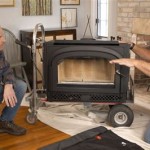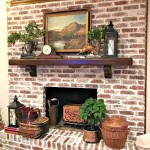Mounting a Television Over a Fireplace: A Comprehensive Guide
Installing a television above a fireplace has become a popular design choice, offering a centralized entertainment area and maximizing space. However, this configuration presents unique challenges that require careful consideration. This article provides a detailed examination of the factors involved in mounting a television over a fireplace, covering crucial aspects such as heat exposure, viewing angles, cable management, and structural integrity.
Assessing the Heat Factor
One of the primary concerns when placing a television above a fireplace is the potential for heat damage. Fireplaces, especially those that burn wood or gas, generate significant heat that can negatively impact the sensitive electronics within a television. Prolonged exposure to high temperatures can lead to screen discoloration, component failure, and a shortened lifespan for the device. It's crucial to thoroughly evaluate the heat output of the fireplace before proceeding with installation.
To mitigate heat-related risks, several strategies can be implemented. First, consider the type of fireplace. Electric fireplaces generally produce less heat than traditional wood-burning or gas-burning models. If using a gas or wood-burning fireplace, measure the temperature above the mantel or proposed TV location while the fireplace is in operation. Use a thermometer to monitor the temperature over a period of several hours, paying close attention to peak temperature readings. If the temperature consistently exceeds the television manufacturer's recommended operating range, mounting the TV directly above the fireplace might not be suitable.
A mantel, if present, plays a significant role in deflecting heat. A wider and deeper mantel provides more effective protection. Extending the mantel further out from the wall helps to redirect heat away from the television. If a mantel is insufficient or absent, consider installing a heat shield. These shields are typically made of metal and designed to deflect heat upward and away from the television. They can be purchased commercially or custom-built to fit the specific dimensions of the fireplace and television.
Another option is to increase the distance between the fireplace and the television. The higher the television is mounted, the less direct heat it will receive. However, this introduces potential viewing angle issues, which will be discussed later. Combining multiple heat mitigation strategies, such as a wider mantel and a heat shield, provides the most robust protection for the television.
It is also crucial to ensure proper ventilation around the television. Avoid enclosing the television within a tight alcove or cabinet above the fireplace, as this can trap heat and exacerbate the problem. Adequate airflow allows heat to dissipate more effectively, helping to maintain a safe operating temperature for the device.
Optimizing Viewing Angles
Beyond heat, the viewing angle is another significant consideration when mounting a television over a fireplace. Placing a television too high can result in neck strain and an uncomfortable viewing experience. Ideally, the center of the television screen should be at eye level when seated. However, this is often not possible when mounting above a fireplace, as the fireplace itself dictates the height of the installation.
To determine the optimal viewing height, measure the distance from the floor to the average eye level of viewers when seated in their primary viewing positions. This measurement provides a target height for the center of the television screen. Compare this target height to the potential mounting height above the fireplace. If the difference is significant, consider strategies to improve the viewing angle.
One effective solution is to use a tilting television mount. A tilting mount allows the television to be angled downward, compensating for the elevated position. This helps to align the screen more closely with the viewer's eye level, reducing neck strain. There are various types of tilting mounts available, ranging from simple models that offer a fixed tilt angle to more advanced models that allow for adjustable tilt. When selecting a tilting mount, ensure that it is compatible with the size and weight of the television. Also, verify that it provides a sufficient range of tilt to achieve the desired viewing angle.
Another option is to consider a full-motion mount, also known as an articulating mount. These mounts, besides tilting, allow the television to be pulled out from the wall and swiveled left or right. This provides maximum flexibility in adjusting the viewing angle and can be particularly useful in rooms with multiple seating areas or where the viewing position varies. Full-motion mounts are typically more expensive than tilting mounts, but they offer a higher degree of adjustability.
When choosing a mount, pay close attention to its weight capacity. The mount must be able to safely support the weight of the television, with a margin of safety built in. Overloading a mount can create a safety hazard and potentially damage the television or surrounding structure.
Managing Cables and Connections
Effective cable management is essential for a clean and professional television installation above a fireplace. Exposed cables can detract from the aesthetic appeal of the setup and create a potential tripping hazard. Furthermore, poorly managed cables can be susceptible to damage from heat or physical stress. Planning a strategy for concealing and organizing cables before beginning the installation process is crucial.
One common method for concealing cables is to route them through the wall. This involves creating an opening behind the television and another opening near the floor or an existing outlet. Cables are then run through the wall cavity, concealing them from view. There are various cable management kits available that include flexible tubes or conduits to protect the cables as they pass through the wall. When running cables through the wall, it is essential to adhere to local building codes and safety regulations.
Another option is to use surface-mounted cable channels. These channels are typically made of plastic or metal and are designed to attach to the wall surface. Cables are then routed through the channels, concealing them from view. Surface-mounted cable channels are a simpler alternative to in-wall routing but may not provide as seamless of a look. They are available in a variety of colors and styles to match the decor of the room.
In either case, it is essential to use high-quality cables that are rated for in-wall use, if applicable. These cables are designed to withstand the temperature fluctuations and physical stresses that may occur within the wall cavity. Also, consider using cable ties or Velcro straps to bundle and organize the cables. This helps to prevent tangling and makes it easier to trace cables in the future.
Ensure that there are sufficient electrical outlets and cable connections near the television mounting location. If necessary, have a qualified electrician install additional outlets or relocate existing ones. Avoid using extension cords or power strips to power the television, as these can be a fire hazard. Similarly, ensure that any necessary cable connections, such as HDMI or coaxial cables, are readily accessible.
Consider using a recessed outlet specifically designed for mounting televisions. These outlets are designed to sit flush with the wall, providing a clean and discreet way to connect the television to power. They typically include surge protection to protect the television from power surges.
Ensuring Structural Integrity and Safety
Before mounting a television above a fireplace, it is crucial to assess the structural integrity of the wall. The wall must be strong enough to support the weight of the television and the mounting hardware. Failure to properly assess the wall's structural capacity can result in the television falling and causing damage or injury.
Start by identifying the type of wall construction. Common wall types include drywall, plaster, brick, and concrete. Drywall is the most common type of wall construction in residential buildings. It is relatively easy to work with, but it is not particularly strong. Plaster walls are typically stronger than drywall walls, but they can be more challenging to drill into.
Brick and concrete walls are the strongest types of wall construction, but they require specialized tools and techniques to drill into. If the wall is made of drywall or plaster, it is essential to locate the wall studs. Wall studs are vertical wooden or metal beams that provide structural support for the wall. The television mount must be securely anchored to the wall studs to ensure that it can support the weight of the television.
Use a stud finder to locate the wall studs. Stud finders are electronic devices that detect the presence of wall studs behind the drywall. Mark the location of the studs with a pencil. When drilling into the wall studs, use screws that are long enough to penetrate the stud adequately. The specific length of the screws will depend on the thickness of the drywall and the depth of the stud. Consult the mount manufacturer's instructions for recommended screw lengths.
If the wall studs are not located in the ideal position for mounting the television, consider using a mounting plate. A mounting plate is a large metal plate that is attached to multiple wall studs. The television mount is then attached to the mounting plate. This distributes the weight of the television across multiple studs, providing a more secure and stable installation.
For brick or concrete walls, use appropriate anchors and screws designed for these materials. These anchors typically expand when inserted into the wall, providing a strong and secure hold. Follow the anchor manufacturer's instructions carefully when installing anchors in brick or concrete.
Always prioritize safety when installing a television. Disconnect the power to the circuit breaker before working with electrical wiring. Use appropriate safety gear, such as eye protection and gloves. If you are not comfortable with any aspect of the installation process, consult a qualified professional. Hiring a professional installer can ensure that the television is mounted safely and securely, minimizing the risk of accidents or damage.

Can I Mount My Tv Above The Fireplace

Can I Mount My Tv Above The Fireplace
Can I Mount A Tv Over My Fireplace Heatilator

Safely Mount A Tv Above An Electric Fireplace Touchstone Home S Inc

3 Alternatives To Mounting Your Television Above The Fireplace Avs

Is It Safe To Mount Your Tv Above The Fireplace Chimney And Wildlife

Can I Mount A Tv Over My Fireplace Warming Trends

Ortal S Innovative Technology Makes It Safe To Mount A Tv Above Your Fireplace

Things To Consider Before Mounting Your Tv Over Fireplace

How To Mount A Tv Over Fireplace Vertical Chimney Care
Related Posts








